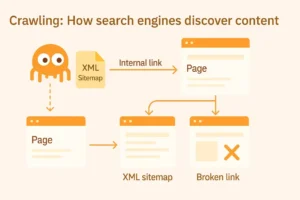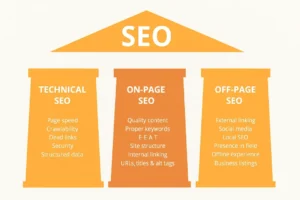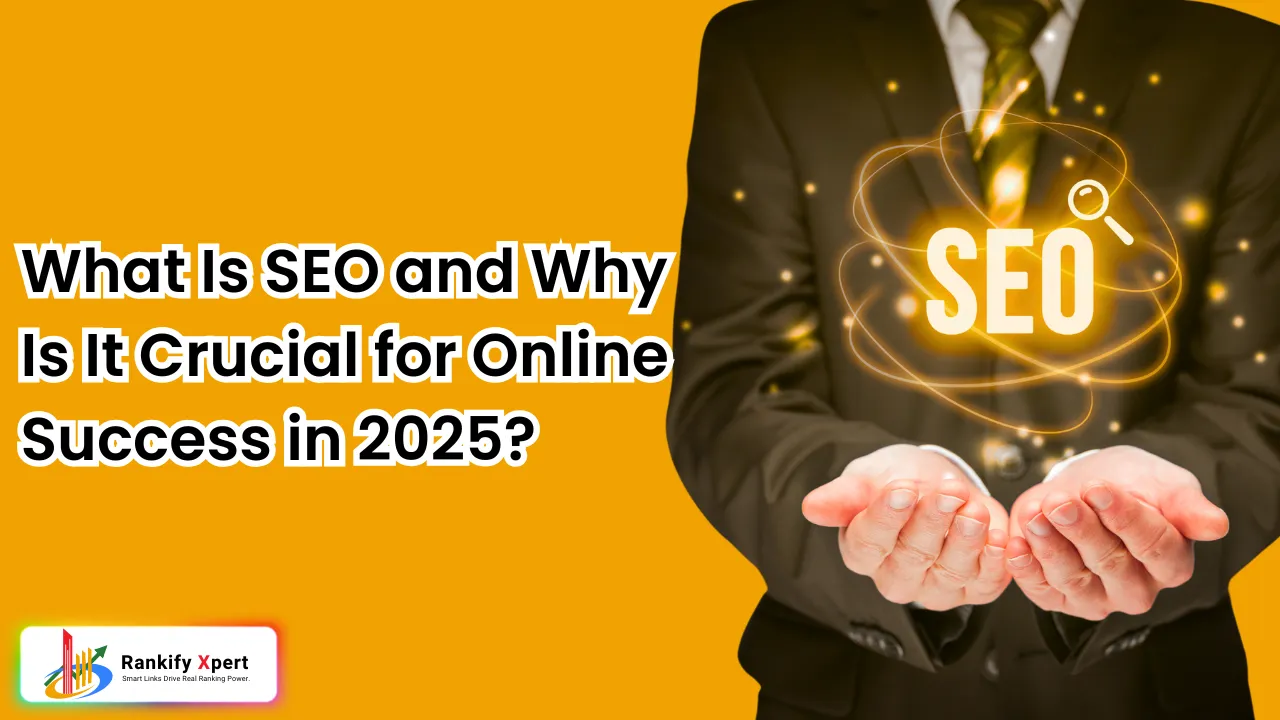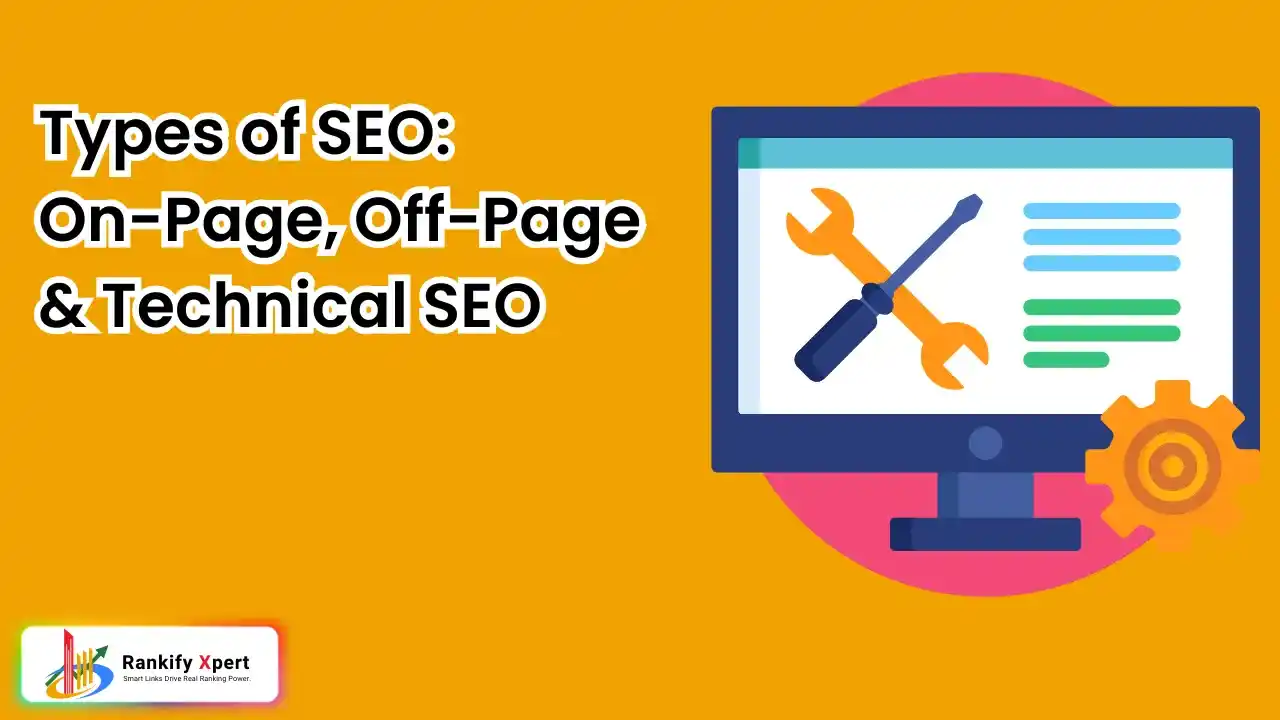What is SEO? SEO or Search Engine Optimization is fundamentally about helping search engines understand your website’s content and connect it with users by delivering relevant, valuable results based on their search queries. The primary goal is to rank on the first page of search engine results pages (SERPs) for the most relevant keywords that resonate with your target demographic, ultimately driving qualified traffic to your site. This digital marketing practice can be applied to any website, whether it improves visibility on search engines like Google and Microsoft Bing for products, services, or expert knowledge on a specific topic.The more visible your pages are in search results, the easier it is for people to find you and that means more potential customers visiting your site. SEO is a must for both beginners and businesses because it levels the playing field helping smaller websites stand out, attract organic traffic without depending on ads, and build trust by showing up at the top of search results. Most of your website traffic comes from organic searches, which is why SEO is such a powerful tool in digital marketing today. Whether you’re running a blog, an online store, or a local business site, understanding SEO can significantly increase your reach and success in the digital landscape.
How Does SEO Work Behind the Scenes?
SEO works by helping search engines make sense of your website’s content, so it shows up in the right searches. It all comes down to three main steps: crawling, indexing, and ranking. From my years of working with websites, I’ve seen how mastering these fundamental stages can transform a struggling site into a traffic magnet.
Crawling: How Search Engines Discover Content
Search engines use bots called crawlers or spiders to scan the internet by jumping from one link to another. If your site has a clear structure and fresh content, these bots can easily discover and index all your pages.To ensure search bots can effectively crawl your site, you need to use an organized site structure with strong internal linking. I always recommend clients create an XML sitemap to guide search engine crawlers through their website systematically. It’s crucial to regularly update your content to signal freshness to search engines, while making sure to avoid broken links and fix any crawl errors that appear in Google Search Console.

Indexing: How Search Engines Store Content
After your site is crawled, its pages are analyzed and stored in a giant database called the search index. When someone searches for something relevant, those indexed pages can show up in the results. To help your pages get indexed properly, use clear, keyword-rich headings, and don’t forget to add meta tags and alt text to images it helps search engines better understand your content. Always avoid duplicate content that can confuse search engines, and regularly check Google Search Console for index coverage issues.
Ranking: How Search Engines Order Results
Once your pages are indexed, search engines decide how to rank them based on things like relevance, quality, and user experience. The better your page matches what someone’s searching for, the higher it’ll show up in the results—and that means more chances of getting clicks. If you want better rankings, focus on creating high-quality content that truly matches what users are searching for plus, make sure your site loads quickly and works well on mobile devices. Building backlinks from authoritative websites and consistently monitoring performance using SEO tools like Moz and Google Analytics will help you determine what results to show and in what order.
Understanding Ranking Factors
Search engines use complex ranking factors – also known as ranking signals – which are characteristics of a page that search engines look at to determine how relevant that page is for a specific search query. While the exact list of ranking factors and their importance remains somewhat of a mystery and changes from time to time, we have a pretty good idea of the most important ones. The quality, relevance, and usability of your content tops the list, followed by external and internal links, the technical aspects of your site including security, and the overall user experience on your site encompassing site speed, easy navigation, and mobile parity. Your overall online presence as a brand also plays a significant role in how search engines evaluate your authority.
Getting Started with SEO Optimization
In addition to these top-ranking factors, there are plenty of others both known and unknown that influence your search visibility. To get a head start with SEO, it makes sense to focus on these core aspects first rather than getting overwhelmed by every possible optimization. If you want to quickly check your page’s performance, you can count on tools like an SEO Checker tool to help you flag issues and provide recommendations on how to improve your search engine presence systematically.
Why SEO is Your Digital Marketing Game-Changer
In my years of digital marketing, I’ve watched businesses transform their online presence through strategic SEO efforts, and the statistics back up what I’ve witnessed firsthand. Organic search consistently delivers 53% of all website traffic according to a 2019 BrightEdge study, making SEO a critical marketing channel that no business can afford to ignore. When you consider that more than 8.5 billion searches happen every day on Google Search, and Google owns 91% of the global search engine market, the incredible audience reach becomes undeniable.
It’s no surprise that this massive opportunity has, in turn, pushed the global SEO industry to be forecast to reach a staggering $122.11 billion by 2028. What makes SEO so powerful is how it drives real business results for brands, businesses, and organizations of all sizes by tapping into a fundamental human behavior – the act of searching has become second nature for internet users worldwide, serving as their primary way to access any information sought within the vast sea of billions of webpages (currently 4.3 billion pages exist on the indexed web as of September 2024).
Understanding Modern Search Behavior Patterns
What fascinates me most about today’s digital landscape is how search has become incredibly fragmented, especially for consumer-intent activities. Smart users now may search across traditional web search engines like Google and Microsoft Bing, explore social platforms including YouTube and TikTok, or browse retailer websites such as Amazon depending on their specific needs. The data reveals shifting consumer preferences: last year, 56% of U.S. online shoppers started their product search on Amazon, while only 46% started on a search engine like Google.
What’s also worth noting from that same research is how diversified the starting points have become – 37% start on Walmart, 25% start on YouTube, 20% start on Facebook, 19% start on Instagram, and 19% start on TikTok. Another interesting aspect of this data compared to previous years shows remarkable growth in social sources, particularly TikTok, as a preferred place to search for both products and knowledge searches (you know, those “how to do X” types of search activities). When it comes to Gen Z, the numbers are eye-opening: a staggering 51% of women in this age group actually prefer to start a search on TikTok above all other online sources of information, according to a 2023 study.
The Sustainable Marketing Advantage
Here’s what separates SEO from every other marketing strategy I’ve implemented: sustainability and competitive positioning. With trillions of searches being conducted every year, search has become the primary source of traffic for most websites, which makes it essential to be “search engine friendly” across any platform where people might search for your brand or business. In simple terms, the higher you rank in search results compared to your competitors, the more visibility and clicks you get—and over time, that can seriously boost your business’s bottom line.
SEO becomes incredibly important when you realize that search engine results pages (or SERPs) are super competitive spaces filled with various search features and PPC ads. These SERP features include AI Overviews, knowledge panels, featured snippets, maps, images, videos, top stories (news), People Also Ask sections, and carousels. Another reason SEO proves critical for brands and businesses lies in its longevity: unlike other marketing channels, good SEO work remains sustainable over time. When any paid campaign ends, so does the traffic it generated. Meanwhile, traffic from social media traffic is at best unreliable and represents just a fraction of what it once was.
Strategic Integration and Trust Building
Smart businesses recognize that SEO functions as the foundation of holistic marketing, where everything your company does ultimately matters for search visibility. Once you truly understand what your users want and need, you can then implement that valuable knowledge across all your campaigns (both paid and organic), your website content, and your social media properties for maximum impact. Organic search operates as a channel that drives exactly the kind of traffic you need to achieve your most important key business goals like conversions, visits, and sales.
Beyond traffic generation, it also builds genuine trust with your audience – any website that ranks well in search results is generally regarded as authoritative and trustworthy, which represent key elements that Google wants to reward with better rankings. SEO plays a crucial role in ensuring your website successfully reaches the right audience at the perfect moment. In addition to pure search visibility, strategic SEO drives quality traffic, systematically improves user experience, and helps your brand stand out in crowded search results.
Maximizing Visibility Through Advanced Features
The evolution of search has created unprecedented opportunities for visibility that extend far beyond traditional rankings. Increased traffic comes naturally when ranking higher in search results increases your website’s overall visibility, effectively driving more clicks from users who are actively searching for your specific content, products, or services. Unlike the temporary nature of paid advertising, this traffic proves sustainable and actually grows when you consistently maintain your optimization efforts.
Modern SEO strategies help your content appear not only in standard traditional search results but also in specialized search engine results page (SERP) features such as valuable featured snippets that display quick answers prominently at the top of search results, dramatically increasing visibility and click-through rates. The People also ask (PAA) feature highlights related user questions, strategically positioning your content as an authoritative resource, while image and video packs effectively showcase visual content, attracting significantly more engagement for searches needing multimedia answers.
Emerging generative search features like AI Overviews represent summaries of web pages that are automatically generated by sophisticated AI algorithms that aim to provide users with quick and detailed answers without requiring them to click through to the original website. This increased visibility can drive substantially more organic traffic to your site, as users are demonstrably more likely to click on links that are accompanied by an AI Overview. Recent research from Ziff Davis shows that LLMs like Open AI clearly prefer content from authoritative websites. Hence, optimizing for SEO significantly increases your chances of appearing in generative search features like AI overviews, ChatGPT, and Claude AI.
Technical Excellence Meets User Satisfaction
The relationship between SEO and user satisfaction creates a powerful synergy that benefits everyone involved. Providing a great user experience demonstrates how SEO goes hand-in-hand with exceptional user experience design. Search engines consistently prioritize websites that are demonstrably fast, mobile-friendly, and easy to navigate. This is precisely where Core web Vitals come in as a set of performance metrics that measure essential aspects of page experience. Loading performance specifically measures how fast your page content appears (tracked through Largest Contentful Paint), and faster loading directly improves user retention and overall satisfaction.
Interactivity refers to how quickly users can engage with your site (measured by First Input Delay) – sites that respond instantly consistently keep users engaged and satisfied. Visual stability prevents jarring layout shifts as the page loads (measured by Cumulative Layout Shift), creating a stable page experience that ensures users don’t accidentally click the wrong elements due to shifting content.
The Three Pillars of SEO Success
When optimizing any site, the work generally involves three key focus areas that work together like a well-orchestrated symphony: on-page, off-page, and technical SEO. From my years of helping businesses climb search rankings, I’ve learned that mastering these interconnected pillars is what separates successful websites from those that remain invisible in search results. On-page SEO focuses on optimizing individual pages to improve search visibility and user experience, while off-page SEO refers to actions taken outside your website to improve search engine rankings. Meanwhile, technical SEO ensures search engines can efficiently crawl, index, and rank your site by addressing the foundational elements that make everything else possible.

Mastering Content and Structure Through On-Page Optimization
The art of on-page SEO involves aligning your content, HTML elements, and site structure with proven SEO best practices in ways that ensures search engines understand your pages while simultaneously making them more engaging for visitors. The key aspects of effective on-page SEO include strategic keyword optimization where you use relevant keywords naturally throughout titles, headers, and body content to perfectly match search intent.
Smart optimization of meta tags means you optimize title tags and meta descriptions to improve click-through rates from search results, while maintaining content quality requires you ensure your content remains original, valuable, and satisfies user intent at every touchpoint. The strategic use of multimedia elements like images, videos, and infographics can enrich user experience when you’re consistently optimizing them with descriptive alt text. Effective internal linking strategies interlink related pages within your site to help search engines discover and rank more content, while creating a logical URL structure means you create clear, descriptive URLs that accurately reflect page content.
Building Authority Beyond Your Website Boundaries (Off-Page SEO)
Off-page SEO strategies build authority and credibility by showing search engines that others value your content through external validation signals. The key off-page strategies include sophisticated link building efforts where you earn high-quality backlinks from authoritative sites through strategic outreach, guest blogging, and content promotion initiatives. Managing citations means you ensure your business information stays consistent across relevant directories, while leveraging social media marketing allows you to promote content across platforms to drive engagement and attract valuable links.
Strategic PR and influencer outreach efforts gain visibility by collaborating with industry influencers and media platforms, while monitoring brand mentions becomes crucial since even without a direct link, brand mentions can signal authority to search engines. For local businesses, implementing local SEO strategies involves creating comprehensive local business profiles and building local unstructured citations that establish geographic relevance.
Technical Foundation for Search Engine Success (Technical SEO)
The technical SEO foundation focuses on site architecture, speed, and user experience elements that determine whether search engines can properly access and evaluate your content. Essential technical SEO tasks include establishing solid site architecture to ensure a clear structure with intuitive navigation and strategic internal linking pathways. Optimizing Core Web Vitals requires you optimize loading speed, interactivity, and visual stability to enhance user experience across all touchpoints, while ensuring mobile-friendliness means you ensure responsive design for seamless browsing across devices. Implementing structured data involves adding schema markup to help search engines understand your content better, while proper indexing management requires you use robots.txt, canonical tags, and XML sitemaps to guide search engine crawlers effectively.
Security and Trust Signals
The final piece of technical optimization focuses on security measures where you ensure your site uses HTTPS to protect user data and improve trust with both users and search engines. This security layer has become increasingly important as search engines prioritize websites that demonstrate they take user safety seriously. When all three parts of SEO work smoothly together, you get a strong strategy that not only helps search engines understand your content but also gives visitors a great experience keeping them engaged and more likely to return.
Getting Started: Your SEO Journey Made Simple
When you’re ready to apply SEO best practices to make your site easier to find, navigate, and rank higher in search results, these foundational steps will strengthen your SEO foundation whether you’re starting fresh or improving existing efforts. From my experience working with countless websites, the secret lies in understanding that keyword research helps you identify what your audience searches for, ensuring your content matches their needs and improves search visibility.
Here are a few tips to conduct effective keyword research that include smart strategies: identify seed keywords based on your core topics or services, use powerful keyword tools like Moz for valuable insights, and always focus on search intent – whether informational, commercial, navigational, or transactional. Smart marketers target long-tail keywords with lower competition and higher relevance, then analyze competitor keywords to find untapped gaps and opportunities.
Creating Content That Converts and Ranks
Content is at the heart of SEO. It helps people find useful information and also gives search engines a clearer picture of what your site is about. High-quality content answers user queries, boosts engagement, and increases the chances of earning valuable backlinks from other websites. The few tips for successful content creation include these proven strategies: create valuable content that addresses user needs while incorporating relevant keywords naturally, address common user pain points with clear solutions, and structure your content with clear headings and short, scannable paragraphs. Always ensure your content is original, accurate, and provides real value to readers, then regularly update your content to keep it relevant and competitive. Don’t forget to enhance your content with relevant images, videos, and infographics that make complex information digestible.
Mastering Technical Elements for Search Success
On-page SEO helps users find relevant content and improves how search engines understand your site structure and purpose. The few tips to optimize your on-page SEO include these essential practices: write compelling, keyword-rich title tags under 60 characters for maximum impact, write clear, concise meta descriptions to improve click-through rates from search listings, add descriptive alt text to images for both accessibility and SEO benefits, and create short, descriptive URLs that include your target keywords. These technical elements work together to signal relevance and quality to search algorithms.
Building Authority Through Strategic Link Building
Quality backlinks from trusted websites signal authority and improve rankings in ways that can transform your search visibility. The few ways to earn valuable links include these time-tested approaches: publish high-quality, shareable content that naturally attracts links from other sites, reach out to relevant industry sites for link opportunities, contribute guest posts to authoritative blogs in your niche, identify and replace broken links with your superior content, and gain brand mentions through strategic PR campaigns and media outreach. For further reading on advanced techniques, you can learn more about how to do comprehensive keyword research using our detailed guide that covers everything from competitor analysis to intent mapping.
How We Can Help You Grow with SEO
Understanding what is SEO is just the beginning of your digital success journey transforming that foundational knowledge into real, measurable growth is precisely where our expertise becomes invaluable. At Rankify Xpert, we specialize in helping businesses grow through strategic contextual backlinks, guest posting on high-authority sites, and completely tailored off-page SEO strategies that align with your unique market position. Our comprehensive approach doesn’t stop there our AI-powered content writing service ensures you consistently have access to high-quality, search-optimized content that genuinely speaks to your audience while achieving the rankings your business deserves. We understand that every business has different goals, which is why our strategies are never one-size-fits-all but carefully crafted to deliver the specific results that matter most to your growth trajectory.
Conclusion
Now that you understand what is SEO and its fundamental components, you’re equipped with the knowledge to begin your journey toward improved search visibility and sustainable online growth. SEO isn’t just a technical exercise it’s a comprehensive strategy that combines content creation, technical optimization, and authority building to help your website connect with the right audience at the perfect moment. The beauty of SEO lies in its long-term benefits: unlike paid advertising that stops delivering results the moment you stop paying, effective SEO work continues to drive organic traffic, build trust, and improve your search engine rankings over time.
Whether you’re starting fresh with a new website or improving existing efforts, remember that SEO success comes from consistent application of best practices across all three pillars: on-page, off-page, and technical SEO. The digital landscape will continue evolving with new AI features, changing search behaviors, and emerging platforms, but the core principles of providing valuable content, maintaining excellent user experience, and building authority will remain constant. Success in SEO requires patience, persistence, and a commitment to understanding and serving your users’ needs but the rewards of increased visibility, qualified traffic, and sustainable business growth make every effort worthwhile.




